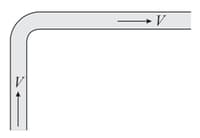MEDIUM
Earn 100
What is the significance of Reynolds number?
Important Questions on Mechanical Properties of Fluids
MEDIUM
EASY
EASY
EASY
HARD
EASY
MEDIUM
Streamline flow is more likely for liquids with
EASY
MEDIUM
EASY
MEDIUM
In deriving Bernoulli’s equation, we equated the work done on the fluid in the tube to its change in the potential and kinetic energy. What is the largest average velocity of blood flow in an artery of diameter if the flow must remain laminar? (Viscosity of blood, , Density of blood, )
EASY
MEDIUM
EASY
MEDIUM
EASY
EASY
MEDIUM
MEDIUM
A fire hydrant (as shown in the figure) delivers water of density at a volume rate . The water travels vertically upward through the hydrant and then does turn to emerge horizontally at speed The pipe and nozzle have uniform cross-section throughout. The force exerted by the water on the corner of the hydrant is

EASY

